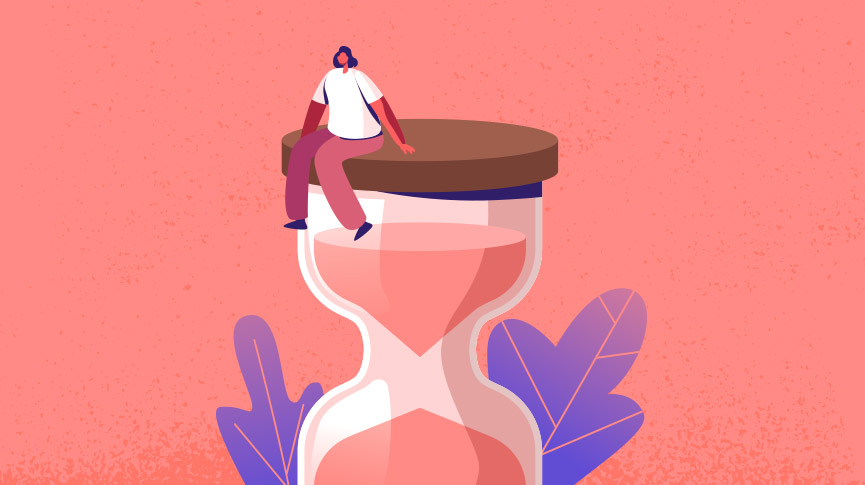Vaginal Changes During Menopause: How To Overcome Them

As we get older we often worry about the effects of aging, scrutinizing each wrinkle and fretting over every jiggle, but we sometimes forget about what’s happening to the parts we can’t see – like our vaginas. First and foremost it’s important to recognize what’s causing most of these changes. As we approach menopause our estrogen levels start to decline and can fluctuate unpredictably as they decrease – which can cause symptoms like hot flashes, mood swings, and vaginal issues. However, unlike hot flashes and mood swings, which taper off when your estrogen levels stabilize after menopause, vaginal changes get worse as we age – so treating them as soon as you notice them is crucial.
In the following video, Intimina Medical Advisory Board Member and Women’s Health Nurse Practitioner Susan Wysocki explains the vaginal changes that can occur during menopause.
Many menopause changes can be treated using hormone replacement therapy (HRT) and we recommend discussing all of your symptoms and treatment options with your doctor. However, there are also a number of behavioral changes you can make to start combating the symptoms now.
Little (or Big) Bladder Leaks
We don’t like to talk about it, we don’t like to call it what it is, but incontinence is a very common part of aging – especially for women. Factors like hormonal changes and childbirth weaken the pelvic floor, and thinner, more fragile tissue makes bladder irritation more likely, so it’s unsurprising that nearly 1 in 3 women suffers from bladder issues in their lifetimes.
Solution: The #1 doctor-recommended treatment for incontinence is pelvic floor exercise. Also known as Kegel exercises, a series of contract and release movements of the pelvic floor, help strengthen the muscles that help support and control your bladder and bowel – which means they help you avoid those leaks. Kegel exercise can actually help with a large number of other menopause symptoms as you’ll see below.
Dryness
Estrogen encourages blood flow in the pelvic region, stimulating the production of vaginal fluid that helps lubricate your vagina and keep you comfortable. So when estrogen is low, less moisture is produced and you might start feeling burning, itching and irritation in places you really don’t want to.
Solution: The first step to solving dryness is to find a pH balanced feminine moisturizer to help with any immediate discomfort. In the long term though, it’s important to increase blood flow to the glands that produce those natural fluids that keep your vagina moist. Kegel exercises do just that: like any exercise, Kegels get your blood flowing, which stimulates those glands to produce more fluid and helps keep dryness and friction to a minimum.
Thinning and Loss of Elasticity
As estrogen levels fall, skin, muscle, and tissue all over the body thins and loses elasticity – and your intimate area is no exception. Without estrogen to maintain the collagen and fat in our cells, the vaginal tissue becomes thinner and the folds that allow it to stretch during sex and childbirth flatten out. This is called vaginal atrophy, it can increase irritation and make intimacy painful.
Solution: This is another area in which Kegels can help – increasing blood flow to those tissues keeps them healthy and flexible, while also encouraging the healing of any damage. A good Kegel device can guide you through each routine – helping ensure that you’re contracting correctly and making each contraction more effective (just like a personal trainer at the gym).
Narrowing or Shortening of the Vagina
Along with the loss of elasticity, if you don’t stimulate the vaginal tissues, your vagina can actually get smaller and tighter – which means when you do try to have sex again, it might hurt.
Solution: More sex! Both sex and masturbation are exercise for your vagina (not to mention the rest of your body), like Kegels it can increase blood flow and lubrication, as well as stimulate the tissue. Whether you’re getting cozy with a partner or enjoying a little “me” time, any sexual activity can help – but having something stretching your vagina helps even more to maintain tissue flexibility over time. If you have pain during intercourse, start slow with external stimulation and gradually work up to insertion. A personal massager is a great way to ease yourself back into it, and you can always use it together with your partner as you get more comfortable.
Loss of Sensitivity
In addition to a lower sex drive during menopause, the decline in estrogen and decreased blood supply to your genitals can also affect the pleasure some women feel from stimulation. The clitoris itself might also become less sensitive – some researchers believe this is due to the lower levels of estrogen combined with vascular and nervous system changes.
Solution: As most women will agree – regardless of age – more foreplay is always a good thing. In menopause this is doubly true, so be open with your partner about what you want and how you want it. Take your time and enjoy the build-up together, intimacy is about more than just reaching a goal.
Increased Infections
Estrogen plays a key part in keeping you infection-free by helping your cells maintain a slightly acidic pH in your vagina – the best environment for the good bacteria that helps keep you healthy and which keeps bad bacteria and microbes from growing. As estrogen falls you might notice more frequent urinary and vaginal infections.
Solution: To avoid infection it’s important not to use any cleansers or lubricants that might change your pH. Avoid douching, even water has a higher pH than your natural vaginal balance, and soaps or fragrances can irritate the tissue or even dry it out – the last thing you want with lower estrogen.
There’s no reason to just live with pain or discomfort from menopause symptoms. Talking to your doctor and committing to a little bit of self-care can go a long way towards staying healthy and comfortable throughout each and every change you experience. Menopause is a natural part of every woman’s life and it has the potential to be just as (or more!) wonderful as every other stage of your life.

A collective group of “lady experts” at Intimina who love sharing our personal experiences, even when they are a little too personal. We believe it’s time to start breaking down the taboos around menstruation, motherhood, and menopause, and start owning our female health.



